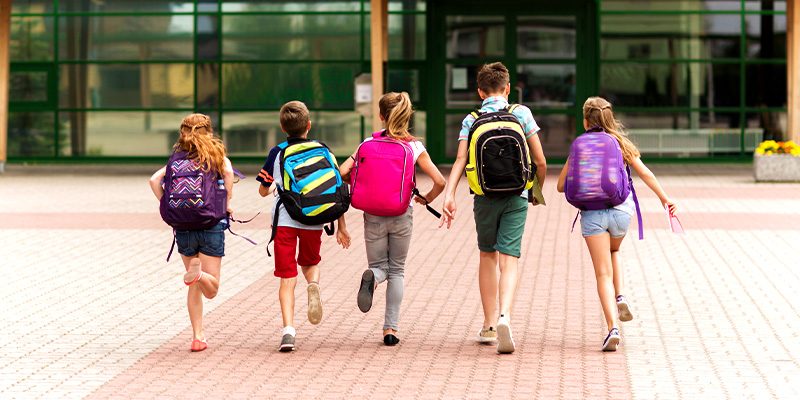
In an era where threats to educational institutions can come from various sources, it’s crucial to have preventative and responsive physical security measures in place. Over the course of the last decade, we’ve seen increased adoption of safety and security measures in public schools in the US. During this period, controlling access to school buildings went up from 92% to 97%, security camera usage increased from 61% to 91%, and faculty and staff wearing badges or picture IDs rose from 63% to 77% (School Survey on Crime and Safety).
In this blog post, we discuss eight effective ways to enhance physical security in K-12 school districts to protect students and staff.

1. Conduct Security Audits and Assessments
Security audits and assessments are crucial tools in improving safety in schools. These processes involve a thorough evaluation of a school’s security measures, policies, and procedures to identify vulnerabilities and develop strategies for improvement. Through security assessments, schools can proactively address weaknesses, enhance preparedness, and maintain a safe learning environment. The most important elements of a security assessment for a school typically include evaluating access control systems, video surveillance systems, perimeter security, emergency response plans, visitor management procedures, staff training, and communication protocols. By examining these elements, schools can create a comprehensive security profile that covers both physical and operational aspects of safety.
Security assessments are typically conducted by security experts like Inteconnex, consultants, or law enforcement agencies with expertise in school safety. These professionals bring an objective and experienced perspective to the evaluation process, identifying potential risks and vulnerabilities that may not be apparent to school administrators. An effective security assessment includes a site visit, interviews with staff, a review of security policies and procedures, and a detailed analysis of the findings. The assessment results are then used to develop tailored recommendations and action plans that schools can implement to enhance their security measures and overall safety. Regularly scheduled assessments, as well as ongoing security audits, are essential to ensure that a school’s security measures remain up-to-date and effective.
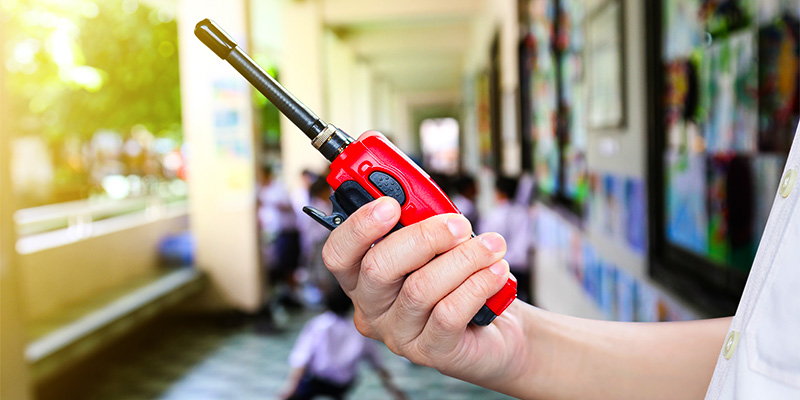
2. Develop and Practice Lockdown Procedures
Lockdown procedures provide a structured and well-rehearsed response to various security threats, including intruders, active shooters, or other emergencies. These procedures typically involve the swift and controlled lockdown of the school, securing students, staff, and visitors in designated safe areas. Schools can implement lockdown procedures through a systematic approach that involves the following steps:
- Development of a Comprehensive Plan: Schools should collaborate with security experts, law enforcement agencies, and relevant stakeholders to create a detailed and tailored lockdown plan. This plan should outline various scenarios and provide clear guidance on when and how to initiate lockdowns, identify designated safe areas, and establish communication protocols.
- Staff and Student Training: Conduct regular training sessions and drills to familiarize staff and students with lockdown procedures. Ensure that everyone understands their roles during a lockdown, including how to secure classrooms or safe areas, communicate effectively, and remain silent.
- Clear Communication: Implement communication systems, such as intercoms, alarms, or digital notifications, to initiate and communicate lockdowns quickly. Ensure that all members of the school community are aware of the specific signals or messages that indicate the need for a lockdown.
- Regular Review and Updates: Periodically review and update the lockdown plan to incorporate lessons learned from drills and real-world incidents. Address any areas of improvement and keep all staff and students informed of any changes to the procedures.
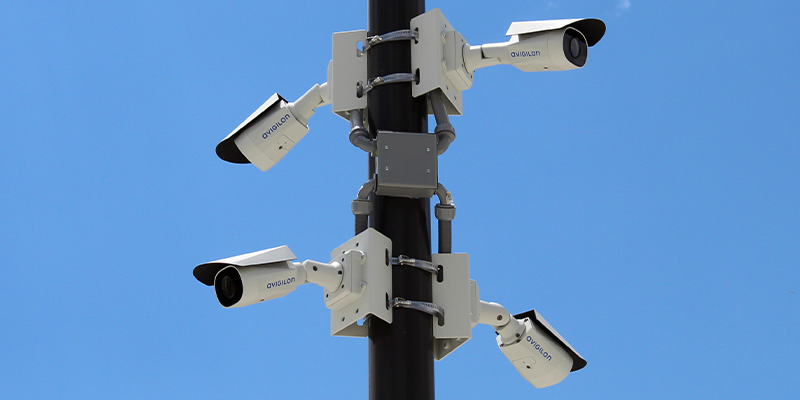
3. Implement a Comprehensive Video Surveillance System
Modern cloud-based or on-premise video surveillance systems are essential for monitoring school premises. Install high-resolution cameras in key locations like entrances, hallways, parking lots, and common areas. These cameras can act as a deterrent and provide valuable evidence to administration and law enforcement when an incident occurs. Video surveillance systems equipped with remote monitoring help ensure a fast response to suspicious activity. There are several benefits of using security camera systems on school grounds:
- Deterrence: The presence of visible cameras can act as a strong deterrent to potential intruders, vandals, and disruptive individuals. Knowing they are being monitored, these individuals are less likely to engage in unlawful or harmful activities on school grounds.
- Incident Detection and Response: Surveillance cameras provide continuous monitoring of school premises, allowing for the prompt detection of security breaches, fights, or other safety concerns. In the event of an incident, security personnel or school staff can respond quickly to address the situation, potentially preventing it from escalating.
- Evidence Collection: In the unfortunate event of a security incident or criminal activity, video footage serves as crucial evidence for investigations and law enforcement. It can help identify suspects, document the sequence of events, and support legal actions, ultimately ensuring accountability and safety within the school environment.
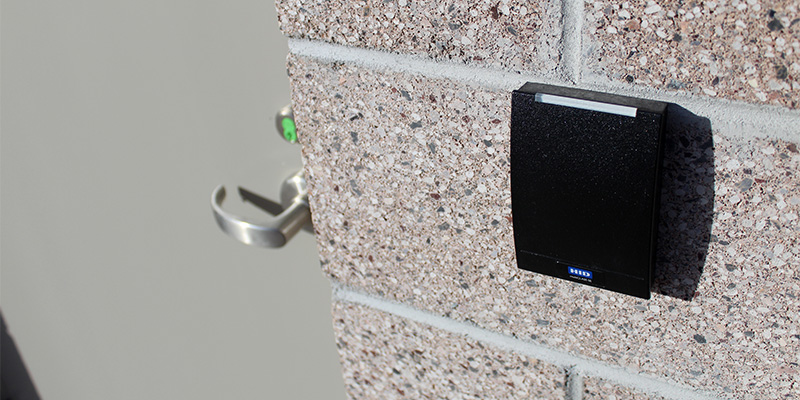
4. Secure the Premises with Access Control
Access control systems can significantly enhance school safety and security by providing a robust and efficient means of regulating who enters and exits school premises. These systems typically involve the use of technologies such as keycards/fobs, mobile devices, biometrics, or PIN codes to grant access to authorized personnel while denying entry to unauthorized individuals. Here are a few of the ways access control enhances school safety:
- Restricted Access: Access control systems enable schools to limit entry to authorized staff, students, and visitors. Using limited points of entry throughout the building helps school personnel monitor who’s coming and going during school hours or special activities. In the event of an emergency, the system can be quickly adjusted to lock down the facility.
- Accountability and Monitoring: Access control systems log entries and exits, allowing school administrators to monitor who enters the premises and when. This data can be valuable for investigating security incidents or tracking attendance. Additionally, integration with video surveillance systems can provide visual verification of individuals accessing the premises, aiding in identifying and responding to security breaches.

5. Security Training for Staff and Students
Implementing training for staff and students is essential in preparing them to respond effectively to security threats. Schools typically conduct regular drills and exercises to familiarize both staff and students with emergency procedures, such as lockdowns, evacuations, and first-aid response. Staff training should encompass recognizing warning signs, communicating threats, and understanding the roles they play during crises. Students can benefit from age-appropriate training that educates them on what to do in an emergency, emphasizing situational awareness and personal safety. A well-trained and informed school community is better equipped to mitigate risks, respond to emergencies, and maintain a secure and orderly environment.

6. Implement Alert Systems
Panic buttons and emergency alarm systems can significantly enhance safety and security in schools by providing a quick and direct means for individuals to alert authorities in case of emergencies. When activated, these buttons immediately notify law enforcement, security personnel, or designated responders of a potential threat or crisis, reducing response times. This rapid communication is vital during situations such as active shooters, medical emergencies, or other threats, as it enables a swift and coordinated response.
Panic buttons can be strategically placed throughout a school, allowing staff, teachers, and students to access them easily, further empowering the school community to take proactive steps in ensuring their safety and minimizing the potential for harm during critical incidents.
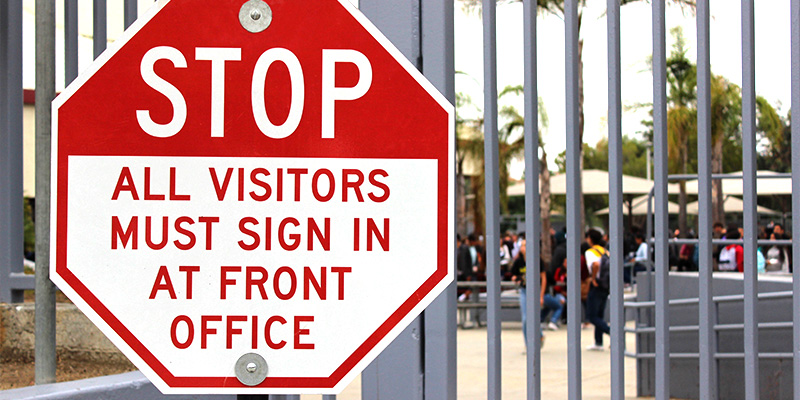
7. Install a Visitor Management System
Another technology-based solution for managing people entering is a visitor management system. These systems typically involve processes such as visitor registration, identity verification, badge printing, and tracking the movements of visitors within a premises. The system can be either a software application or a combination of hardware and software, allowing schools and organizations to enhance security and streamline visitor management procedures. There are several benefits to implementing a visitor management system:
- Enhanced Accountability: By requiring all visitors to check in and provide identification, schools can create a digital record of who is on the premises at any given time. This accountability helps ensure that unauthorized individuals are not wandering the campus.
- Immediate Identification: The system can cross-reference visitor information with databases of known threats or individuals with restricted access, providing immediate alerts if a potential security risk is identified.
- Efficient Communication: In the event of an emergency, schools can use the visitor management system to quickly identify and locate visitors, ensuring that everyone is accounted for and can be safely evacuated or managed during the crisis.
- Streamlined Processes: Implementing a visitor management system simplifies the check-in process, reducing wait times and administrative burdens on staff, making it easier to handle visitors while maintaining a high level of security.
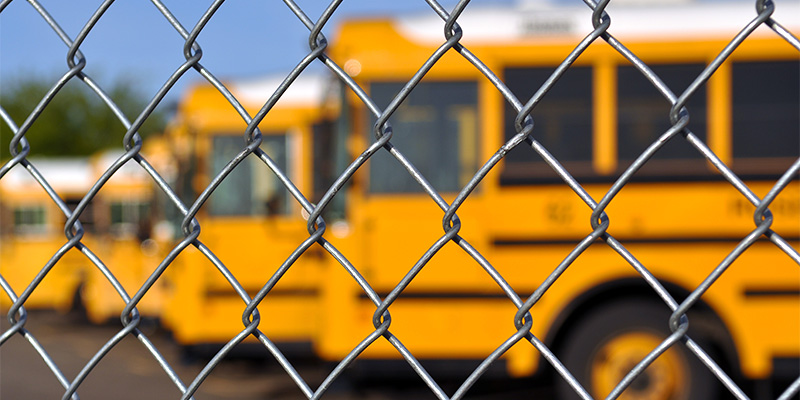
8. Secure the Perimeter with Fencing
A secure perimeter and fencing around a school play a fundamental role in enhancing safety and security. These physical barriers establish clear boundaries, making it more challenging for unauthorized individuals to access the premises, and they serve as a deterrent against trespassers or intruders. Additionally, a secure perimeter can guide visitors to designated entry points, where they can be properly screened and monitored, ensuring that only authorized individuals gain access. Fencing can also help prevent vehicular intrusion, reducing the risk of ramming attacks.
